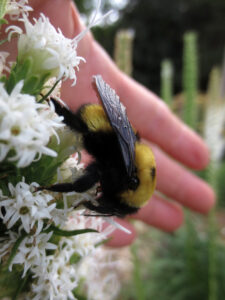Project Overview
Commodities
- Additional Plants: cut flowers, herbs, native plants, ornamentals
Practices
- Crop Production: pollination, pollinator habitat
- Education and Training: on-farm/ranch research
- Natural Resources/Environment: habitat enhancement
Summary:
Abstract
According to 2015 wild bee maps, key agricultural regions in the Western USA are at risk due to declining native bee populations coupled with a rising demand for crop pollination (Koh et al. 2015). These regions need to increase effective pollination habitat while not alienating farmers. Growers want to encourage pollinators but are hindered by lack of knowledge, limited time and labor, and the perception that pollinator habitat is weedy.
[caption id="attachment_618720" align="alignright" width="272"] Bombus nevadensis, one of the largest North American bumblebees, graced our pollinator plot in 2019. This extremely large specimen. which was around one and a half inch long, was likely a queen. She sits on white liatris.[/caption]
Bombus nevadensis, one of the largest North American bumblebees, graced our pollinator plot in 2019. This extremely large specimen. which was around one and a half inch long, was likely a queen. She sits on white liatris.[/caption]
This study has three main goals. First, exploring whether designing pollinator habitat to include plant species with divergent architecture increases native pollinator and beneficial insect diversity and abundance when compared to pollinator habitats containing species with similar architecture. This novel concept will expand research in the field and allow development of more effective multifunctional habitat. Second, evaluating ten economically viable crops, in this case cut flowers, for inclusion in pollinator habitat design based on their ability to attract pollinators and suitability to the Northwest. This will increase grower interest by providing an economic incentive to establish pollinator habitat. Third, encouraging growers to establish more pollinator habitat by developing farmer friendly pollinator plant groupings that are economically profitable, easy to maintain, inexpensive, and non-invasive.
Education and outreach will include local farmers, western growers and pollinator researchers. For local farmers we will have a field tour and presentations on farmer friendly pollinator habitat. To reach out to nonlocal farmers we will develop webpages, an infographic and downloadable pamphlets on creating a habitat for wild pollinators in the Northwest. To further pollinator research we will submit at least one research paper on the effect of diverse plant architecture on native pollinator abundance and diversity.
Project objectives:
1) Evaluate if a more diverse plant architecture influences pollinator and beneficial insect abundance and diversity (year 1-2).
2) Evaluate the suitability of ten different pollinator friendly marketable crops (cut flowers) for inclusion in pollinator habit (year 1-2).
3) Develop easy to establish, non-invasive, cost-effective and obtainable pollinator modules for western farmers (year 2).
4) Encourage adaptation of more effective pollinator habitat among local and regional farmers by developing and distributing educational material for growers on sustaining native pollinators (year 2-3).
5) Survey pollinator diversity and abundance on a WA certified organic farm (year 1-2).
6) Write and submit a research paper(s) on study (year 2-3).